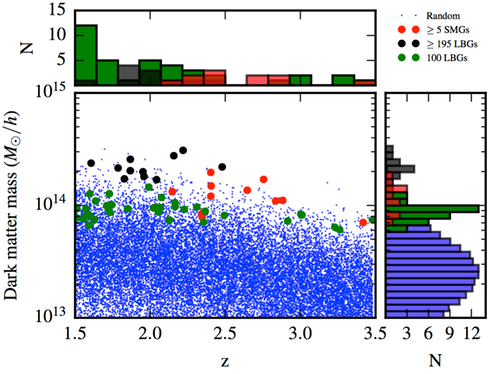Submillimeter galaxies (SMGs) are a class of ultraluminous infrared galaxies (ULIRGs, which are galaxies with infrared luminosity greater than 1012 solar luminosities) at redshifts z ~ 2-4, although the abundance of z > 4 SMGs is still uncertain. Since their discovery in the late 1990s, SMGs have attracted significant interest because of their extreme nature, their potentially significant contribution to the star formation rate density of the Universe, and the difficulty that some models have had when attempting to explain the observed abundance and redshift distribution of SMGs.
Because local (low-redshift) ULIRGs seem to be exclusively late-stage merger-induced starbursts (often with a significant AGN contribution), it is natural to suppose that SMGs are also merger-induced starbursts. In a series of papers, I used the combination of hydrodynamical simulations and dust radiative transfer described above to investigate this possibility and to learn more about the physical nature of the SMG population.
A galaxy's (sub)mm spectral energy distribution is dominated by thermal emission from dust grains, which are heated by energy absorbed from stars and AGN. Thus, (sub)mm observations complement UV-optical observations because the (sub)mm traces obscured star formation and AGN, whereas the UV-optical SED is sensitive to unobscured star formation and AGN emission. The following movie shows a comparison of a simulated galaxy observed in the optical and submm.
Understanding the SMG selection
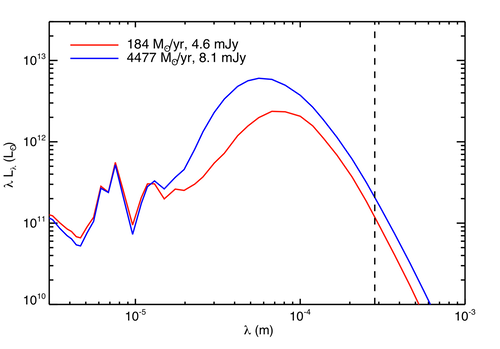
In Hayward et al. (2011), we performed a detailed study of the dependence of our simulated isolated disk and merging galaxies' submm fluxes on the properties of those galaxies. We demonstrated that starbursts are relatively inefficient at boosting a galaxy's submm flux compared with quiescent star formation because (1) starbursts cause the galaxy's SED to become hotter, which mitigates much of the increase in submm flux that would occur if the SED shape were fixed and LIR increased, and (2) the significant contribution to LIR at the time of the burst from 'old' stars causes the scaling between SFR and LIR to be significantly sub-linear. The above figure shows the SED of a merger at the peak of the starburst in blue and during the quiescently star-forming pre-merger phase in red. Note that the SED is significantly hotter (the wavelength of the maximum of the IR SED is shorter) for the starburst. Furthermore, although the SFR at the time of the starburst is 24 times greater than for the quiescently star-forming phase, the observed submm flux density is less than a factor of 2 greater!

Furthermore, because the submm flux-SFR relation is significantly sub-linear for both the quiescent and starburst star formation modes, blending multiple galaxies into a single source - which occurs often for single-dish submm telescopes because of their large (~15", or ~130 kpc at z ~ 2-3) beam sizes - can increase the submm flux more effectively than can mergers. The effect of blending is demonstrated in the above figure (adapted from Hayward et al. 2012), which shows observed-frame 850-micron continuum maps for a simulated early-stage merger at various resolutions: from left, the intrinsic simulation resolution (~200 pc), 0.5" (e.g., the PdBI and ALMA), 7" (e.g., Herschel PACS and the current configuration of the LMT), and 15" (e.g., the JCMT). Although the two disk galaxies are separated by ~100 kpc, they would be blended into a single source in typical single-dish submm surveys. The below movie reinforces the importance of blending by showing how the observed-frame submm emission of a merger would appear at different times when viewed with a typical single-dish submm telescope (spoiler alert: a blob).
The effects described above cause the SMG population to be more complicated than previously assumed: they are not simply late-stage merger-induced starbursts but rather a heterogeneous collection of starbursts, early-stage quiescently star-forming mergers for which the galaxies are blended into a single submm source, physically unrelated galaxies blended into a single source, and, at the faint end, isolated disks. In follow-up papers, we explored how to isolate the starburst SMGs from the general population and determined the relative contributions of the subpopulations.
How can we distinguish the different SMG subpopulations?
In Hayward et al. (2012), we presented diagnostics that can be used to distinguish these subpopulations using integrated SEDalone. For example, we demonstrated that one can use the effective dust temperature (Td) to select starbursts from the general SMG and hot-dust ULIRG (i.e., ULIRGs not detected in the submm) populations. The predicted LIR- Td relation (see the plot below, from Hayward et al. 2012) and the Td cut that distinguishes starbursts from quiescently star-forming galaxies are in excellent agreement with Herschel observations. Note that at a given LIR, the starbursts (blue squares) have higher effective dust temperatures. Other useful diagnostics include the global 'star formation efficiency' (the ratio of IR luminosity to gas mass), the infrared excess (the ratio of IR luminosity to far-UV luminosity), and the specific star formation rate.
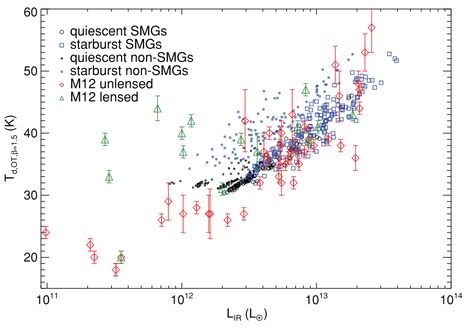
SMG number counts, blending, and the stellar initial mass function
Some previous theoretical models have suggested that a top-heavy initial mass function (IMF) may be required to explain the observed number counts of SMGs while still matching constraints such as the z ~ 0 mass function. The reason the IMF is intimately tied to the submm counts predicted by models is that, for a fixed star formation rate, forming relatively more massive stars (i.e., a top-heavy IMF) results in higher luminosity and more metals, and thus dust; the latter causes the SED to become cooler. Both the increased luminosity and cooler SED yield a significant increase in the submm flux per unit SFR.
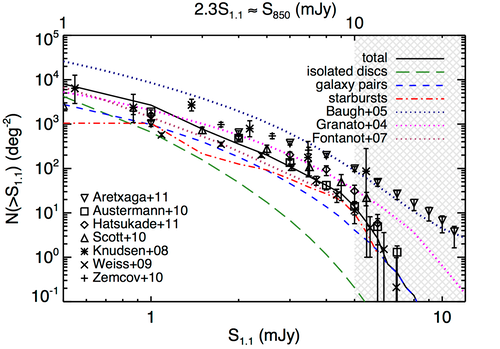
Partially motivated by the above claim, we used a semi-empirical model (Hopkins, Younger, Hayward et al. 2010) to put the simulated SMGs in a cosmological context (Hayward et al. 2013a). We investigated whether our model could reproduce the observed SMG counts without recourse to IMF modification and determined the relative contributions of the various subpopulations. The SMG counts (see the above figure) and redshift distribution predicted by our model are in good agreement with the most recent observations (the points with error bars shown on the plot) for fields for which the counts are thought not to be boosted significantly by gravitational lensing, which suggests that the SMG counts do not provide evidence for a top-heavy IMF.
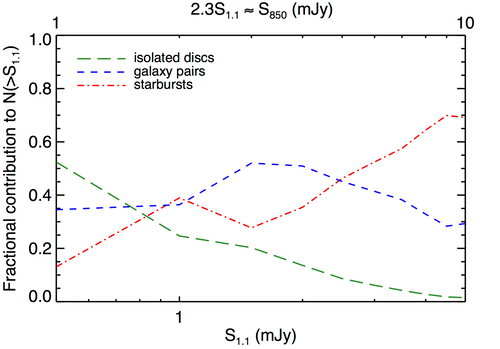
Furthermore, our model predicts that a significant fraction (~30-50 percent) of the bright single-dish-detected SMGs are multiple sources blended into one source (see the galaxy pair contribution in the above figure). Since the the Atacama Large Millimeter Array (ALMA) came online, observational support for our predictions has been rapidly accumulating, as all follow-up studies have found that a significant fraction of single-dish submm sources break up into multiple components when observed with ALMA (e.g. Karim et al. 2013, Hodge et al. 2013, Bussmann et al. 2015, Miettinen et al. 2015, Simpson et al. 2015). Because the quiescently star-forming galaxy-pair SMGs are physically distinct from late-stage starburst SMGs, one should use the diagnostics presented in Hayward et al. (2012) to isolate a subsample of starbursts from the general SMG population if one wants to cleanly study the starburst star-formation 'mode' at high redshift and to make 'apples-to-apples' comparisons with local ULIRGs.
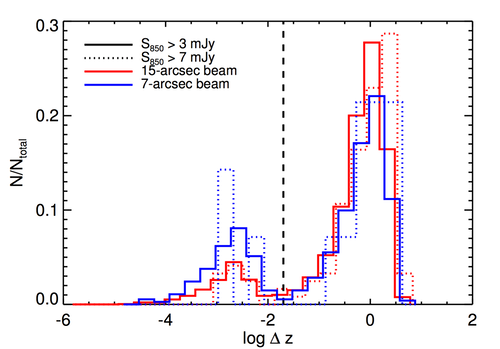
Early-stage mergers are not the only possible type of blended sources; rather, chance projections of physically unrelated galaxies can contribute. In Hayward et al. (2013b), we used a combination of mock galaxy catalogs (generated from a cosmological dark matter-only simulation using abundance matching) and the fitting functions presented in Hayward et al. (2011, 2013a). We demonstrated that the majority of blended SMGs should contain at least one component that is physically unrelated (i.e., has a redshift that differs by >> 0.02) from the others. The above figure shows the distribution of the redshift separations of the components of multi-component submm sources. Objects to the right of the line are sources for which at least one of the components is physically unassociated with the other(s). Our model clearly predicts that the majority of multi-component submm sources identified with single-dish submm telescopes should contain at least one physically unassociated components, and subsequent theoretical models have reached similar conclusions. I am currently working to test this prediction by using MOSFIRE and LRIS on the Keck-1 telescope to obtain spectroscopic redshifts for the components of multi-component submm sources.
SMGs as tracers of dark matter overdensities
It is often claimed that associations of SMGs (i.e. multiple SMGs at the same redshift located within a small area on the sky) can serve as beacons of galaxy clusters in formation. Under my mentorship, Dalhousie undergraduate Tim Miller investigated whether this is true using the Hayward et al. (2013b) model. His analysis is presented in Miller, Hayward, Chapman, & Behroozi (2015). Tim performed a counts-in-cells analysis to determine whether SMG associations trace the highest dark matter overdensities in the underlying N-body simulation. He found that at redshifts less than ~2.5, SMG associations are poor tracers of dark matter overdensities for two reasons: (1) because SMGs are rare, they stochastically populate dark matter halos. Thus, at best, they constitute a noisy tracer of dark matter overdensities. (2) At redshifts of less than ~2.5, ‘downsizing’ implies that the massive galaxies contained in the highest overdensities are already no longer rapidly star-forming and thus would not be detected as SMGs. These points are illustrated in the below plot, which shows the dark matter mass contained in different types of cells at different redshifts. The red points correspond to associations of 5 or more SMGs, the black (green) points correspond to associations of at least 195 (exactly 100) less-luminous galaxies (‘Lyman break galaxy’ analogs), and the blue points are randomly selected cells. At redshifts greater than ~2.5, the SMG associations trace some of the highest overdensities (i.e. cells with the highest dark matter masses), but they are a highly incomplete tracer. At lower redshifts, none of the highest overdensities are traced by SMG associations.
